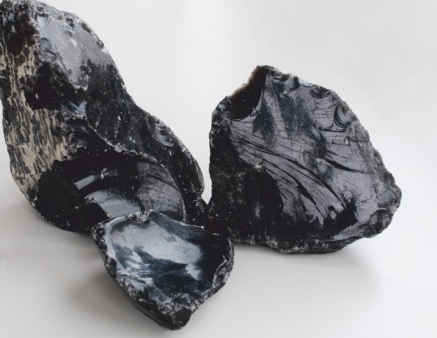OBSIDIAN BLADES

On the pages of the Kurier Kamieniarski magazine, unconventional use of stone has been discussed several times. After stone tools and stone paper, it is time for another episode of our series. This time we are to present the phenomenon of stone weapons, specifically, a type of obsidian swords from Central America called macuahuitl.
To understand the purpose and importance of the weapon it is at first necessary to familiarize with the culture and civilization of ancient Aztecs who inhabited the land of nowadays Mexico back then. Until the beginning of the 16th century, the Aztecs had no encounter with the Europeans, so their civilization had been developing completely independently. Except for obvious cultural differences there existed significant differences in the level of technological progress. Despite incredible knowledge of astronomy, highly developed art, and building pyramids, they had never mastered the art of metallurgy. As a result, they were not able to produce iron swords or armour which were in common use in Europe. But the Aztecs knew well how to process another raw material that was available in their area.
Obsidian – in the Nahuatl language called itztli – is volcanic rock originating from cooling magma. Depending on the type of magma, there exist many kinds of volcanic rocks of different chemical composition. Brown or black obsidian is the most common volcanic rock there, but other types of them exist there, too. Processing is relatively simple; therefore, it was so popular among the civilizations of Central America. The Aztecs used obsidian not only for production of blades and arrow heads but also to produce sculptures and things of daily use. Some scientists claim that role of obsidian blades for the civilizations of Central America can be compared to that of steel in Europe.
The most common and depicted Aztec weapon is the macuahuitl. As for its function, in combat, it was used the same way as a sword, but it looked like a flat mace. Several very sharp pieces of obsidian were embedded in a wooden bat in a way to create the cut surface. A typical macuahuitl is from 90 cm to 120 cm long but there existed shorter or longer versions. There even existed versions long as the height of a grown-up man. According to its size, it can be a single-handed weapon (macahuitl) or a two-handed weapon (macuahuitlzoctli).
If we are to trust the words of Spanish chronicles, an Aztec warrior was able to cut off a horse head by a single stroke. It was a powerful weapon, but it had its disadvantages. Despite being sharp obsidian was very fragile. When meeting swords and armour made of steel obsidian blades splintered or blunted which resulted in their infectiveness. Opinions of researchers on obsidian weapons durability differ. Some say that macuahuitl was a weapon for single use; others think that solidly made weapons together with a unique Aztec warrior style of combat enabled an effective melee attack for a long time. Macuahuitl was much heavier which resulted in bad manoeuvring and slower attack than with a sword. In one of the popular TV shows, participants tried to disprove a hypothesis that it is possible to cut off a horse head with a single blow. To proceed with the experiment a life-size horse head was cast. For its construction a ballistic gel was used for its composition is very similar to the density of animal tissue. Indeed, the head of the horse could not be cut off with a single blow, but probably only because the macuahuitl made for this purpose was not sharp enough. Unfortunately, no single copy of this weapon has survived to this day. The last true macuahuitl was destroyed in a fire that broke out in the armoury of the Royal Palace in Madrid in 1884. Everything we know about this weapon is based on descriptions and engravings. On this basis, many attempts have been made to reconstruct the macuahuitls and test their capabilities.
The Aztecs also used other types of weapons, such as axes (tepoztli) or spears (atlatl), but the macuahuitl aroused the greatest fear and curiosity. In addition to being used in combat, it was probably also used for ritual purposes. The Spanish conquest of Central America marked the end of Aztec civilization, but thanks to surviving accounts and the curiosity of researchers, knowledge of this amazing weapon has survived to the present.

Source: Kurier Kamieniarski
Author: Jakub Zdańkowski | Published: 22.12.2015
